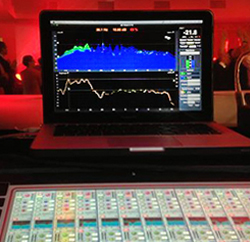
Range Of Interfaces
The interface is a computer peripheral device that acquires and converts analog audio signals to digital for a PC or Mac, and most work with both, though PCs require a “driver file” that Macs do not.
A basic interface for 2-channel measurements needs at least one XLR-input mic preamp with phantom power and one line level input, though an interface with two XLR “combo” inputs that also accept TRS connections helps avoid adaptors.
If you also want to use your interface for recording when not using Smaart, think about getting an interface with two mic preamps. In addition, having two line inputs allows recording stereo room mics plus a stereo board feed at the same time.
Don’t let indecision about a computer interface stop you from getting started. There are a wide variety of units available, starting at a price of about a hundred bucks. Almost everyone makes one. Just be sure to check for compatibility. (And for solid advice and recommendations, stop by the Rational Acoustics and/or ProSoundWeb forums.)
A PreSonus AudioBox USB interface (2 in/2 out) can be had for about $100, or for a few dollars more, there’s the Focusrite Scarlett 2i2 interface (also 2 in/2 out) that’s become popular on many tours.
For power users, the Rational Acoustics Smaart I-O is a measurement grade 2-channel USB interface designed and built specifically for use with Smaart v7. It provides SPL calibration as well as software-controlled gain in 1 dB steps. And multiple Smaart I-Os can be combined for multichannel measurements.
Plenty Of Options
Smaart v.7 runs under Windows XP or newer (including 8.1) and Mac OS X 10.5 and newer, with a 2 GHz dual-core computer with 2 GB of RAM recommended. But because v.7 Di only runs two transfer engines, I’ve found that it works with some older computers, like my first generation single-core black MacBook.
v.7 Di is available at two-thirds the cost ($595) of v.7 ($895). Both provide two installations (“seats”) per license, and can be purchased at the Rational Acoustics online store (as can the RTA-420 mic, Smaart I-O interface, and many other accessories). Registered v.7 users can also purchase a special single-install license of v.7 Di at half price.
Similarly, v.7 Di owners can buy a special single-install license of v.7 for half price, using the new “license add-on” purchase feature within their online license management accounts. For those still using v.6 who prefer a 2-channel to a multichannel system, upgrading to v.7 Di provides an increase in responsiveness and features at a cost of $300.
Rational Acoustics offers a 1-day Smaart Basics class for $250 that provides an introduction to the v.7 Di user interface and covers basic RTA, Spectrograph and Transfer Function measurements. It also offers attendees a 25 percent discount for a Smaart v.7 Di license. In addition, a free 30-day, one-time demo version with minor functionality obstructions is available for download if you want to try out your new computer interface and measurement mic to see how they work with your computer.
Smaart (short for Sound Measurement Acoustical Analysis Real Time, by the way) was inducted into the TEC Hall of Fame at last month’s NAMM show at the relatively young age of 20, having won it’s first TEC Award in 1998. Its introduction at the New York AES show in 1995 has been called the dawn of the modern era of live sound measurement. It’s an industry standard and the one software tool that every pro audio technician should own.
Mark Frink learned how to use Smaart on his first kd lang tour when Jamie Anderson of Rational Acoustics was the system engineer. (Thanks Jamie.)

